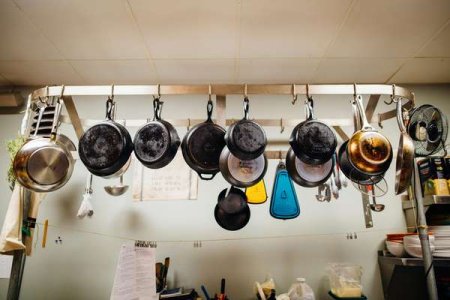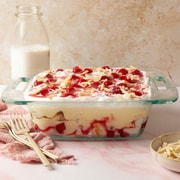Revive Burnt Pots Fast with These 3 Genius Tricks!
By
Aubrey Razon
- Replies 0
Ah, the aroma of a home-cooked meal wafting through the house—it's one of life's simple pleasures. But sometimes, that bliss is interrupted by the all-too-familiar scent of something burning. You rush to the kitchen, only to find your favorite pot sporting a new shade of charred black.
Don't despair, dear readers of The GrayVine! Burnt pots don't mean the end of your cookware's lifespan. With a little elbow grease and some clever tricks, you can restore them to their former glory!
Burnt residue can be a breeding ground for bacteria, and it can also affect the taste of your future culinary creations. Not to mention, it can compromise the non-stick surface of your cookware, making it less effective and shortening its lifespan.
Before you dive into the cleaning process, make sure you're prepared.
Slip on a pair of dishwashing gloves to protect your hands from any harsh cleaning agents or hot water.
If you're using vinegar or a cleaning product, consider opening a window to keep the area well-ventilated.
Different materials require different care. Here's a quick rundown:
After the soak, take a non-abrasive sponge or brush and scrub away the softened grime. Rinse thoroughly and dry to reveal a pot that looks as good as new.
Discard the liquid, give the pot a standard wash with soap and water, rinse, and dry.
Using a soft cloth or non-abrasive scrubber, gently work in circular motions to clean the pot. Rinse off any residue and dry thoroughly.
While steel wool might be tempting for those tough spots, it's best to use it only on stainless steel. Other materials like enamel, cast iron, copper, and non-stick surfaces can be damaged by harsh abrasives.
We understand that your cookware is more than just tools; they're companions in your culinary adventures. Keeping them clean and well-maintained means you're ready to whip up a family recipe or try a new dish at a moment's notice.
Plus, it's a matter of pride—sparkling pots and pans reflect the care and love you put into your meals!

Have you tried any of these methods before? Do you have a go-to trick for tackling tough kitchen cleanups? Share your experiences and tips in the comments below. Let's help each other keep our kitchens in pristine condition, so we can focus on the joy of cooking and the warmth of sharing meals with loved ones!
Don't despair, dear readers of The GrayVine! Burnt pots don't mean the end of your cookware's lifespan. With a little elbow grease and some clever tricks, you can restore them to their former glory!
Why Burnt Pots Are More Than Just an Eyesore
First things first, let's talk about why it's crucial to address those unsightly burnt marks. Beyond the obvious aesthetic reasons, there's a practical side to keeping your pots and pans in tip-top shape.Burnt residue can be a breeding ground for bacteria, and it can also affect the taste of your future culinary creations. Not to mention, it can compromise the non-stick surface of your cookware, making it less effective and shortening its lifespan.
Before You Begin: Gear Up for the Task
Before you dive into the cleaning process, make sure you're prepared.
Slip on a pair of dishwashing gloves to protect your hands from any harsh cleaning agents or hot water.
If you're using vinegar or a cleaning product, consider opening a window to keep the area well-ventilated.
Understanding Your Pots: A Material Matter
Different materials require different care. Here's a quick rundown:
Cast Iron
Contrary to popular belief, a bit of soap won't hurt your cast iron. Avoid soaking it, but feel free to use kosher salt for scrubbing and simmer water to loosen burnt food.Enamelware
For stubborn stains, a gentle cleaner like Bon Ami or Bar Keeper’s Friend can work wonders—just keep it away from your cast iron.Copper
Handle with care. Gentle cloths and a quality copper polish will keep these pots looking their best.Non-Stick Pans
Avoid abrasive materials that can damage the non-stick surface. Gentle scrubbing is key.The Arsenal You'll Need
- Baking soda
- Hydrogen peroxide
- White vinegar
- Non-abrasive sponge or brush
- Dish soap
- A gentle cleaner like Bon Ami or Bar Keeper’s Friend (optional)
The 3 Genius Cleaning Methods
1. The Baking Soda and Hydrogen Peroxide Soak
Combine hydrogen peroxide and baking soda directly in the burnt pot. Let this mixture work its magic for several hours—up to six if you can spare the time.After the soak, take a non-abrasive sponge or brush and scrub away the softened grime. Rinse thoroughly and dry to reveal a pot that looks as good as new.
2. The Vinegar and Baking Soda Boil
Fill the pot with a mixture of water and white vinegar, and bring it to a boil. Once it's bubbling, turn off the heat and sprinkle in baking soda. This will cause a fizzing action that helps lift the burnt residue.Discard the liquid, give the pot a standard wash with soap and water, rinse, and dry.
3. The Gentle Abrasive
Dampen the pot, sprinkle on a gentle cleaner like Bon Ami or Bar Keeper’s Friend, and let it sit for a minute on tougher stains.Using a soft cloth or non-abrasive scrubber, gently work in circular motions to clean the pot. Rinse off any residue and dry thoroughly.
Can You Use Abrasive Cleaners?
While steel wool might be tempting for those tough spots, it's best to use it only on stainless steel. Other materials like enamel, cast iron, copper, and non-stick surfaces can be damaged by harsh abrasives.
Preventative Measures: Tips to Keep Your Pots Pristine
- Choose the right pan for the heat level. Non-stick pans don't fare well on high heat—opt for steel or cast iron instead.
- Heat the pan before adding oil. This creates a natural non-stick barrier.
- Get to know your stove. Keep an eye on your cooking and adjust the heat as needed to prevent burning.
We understand that your cookware is more than just tools; they're companions in your culinary adventures. Keeping them clean and well-maintained means you're ready to whip up a family recipe or try a new dish at a moment's notice.
Plus, it's a matter of pride—sparkling pots and pans reflect the care and love you put into your meals!
Key Takeaways
- Regular cleaning of burnt pots is essential for safety, to prevent foodborne illness, and to ensure the taste of food isn't affected by residue from previous meals.
- Different types of pots, such as cast iron, enamelware, copper, and non-stick pans, require specific cleaning considerations to avoid damaging them.
- There are several methods for effectively cleaning burnt pots, including soaking with baking soda and hydrogen peroxide, boiling with vinegar and baking soda, and using gentle cleaners like Bon Ami or Bar Keeper’s Friend.
- To prevent burning pots in the future, one should choose the right pan for the heat level, heat the pan before adding oil, and become familiar with their stove and cooking equipment to better control the cooking process.
Have you tried any of these methods before? Do you have a go-to trick for tackling tough kitchen cleanups? Share your experiences and tips in the comments below. Let's help each other keep our kitchens in pristine condition, so we can focus on the joy of cooking and the warmth of sharing meals with loved ones!







